Banggu Wu
Virtual Width Networks
Nov 17, 2025



Abstract:We introduce Virtual Width Networks (VWN), a framework that delivers the benefits of wider representations without incurring the quadratic cost of increasing the hidden size. VWN decouples representational width from backbone width, expanding the embedding space while keeping backbone compute nearly constant. In our large-scale experiment, an 8-times expansion accelerates optimization by over 2 times for next-token and 3 times for next-2-token prediction. The advantage amplifies over training as both the loss gap grows and the convergence-speedup ratio increases, showing that VWN is not only token-efficient but also increasingly effective with scale. Moreover, we identify an approximately log-linear scaling relation between virtual width and loss reduction, offering an initial empirical basis and motivation for exploring virtual-width scaling as a new dimension of large-model efficiency.
UltraMemV2: Memory Networks Scaling to 120B Parameters with Superior Long-Context Learning
Aug 26, 2025



Abstract:While Mixture of Experts (MoE) models achieve remarkable efficiency by activating only subsets of parameters, they suffer from high memory access costs during inference. Memory-layer architectures offer an appealing alternative with very few memory access, but previous attempts like UltraMem have only matched the performance of 2-expert MoE models, falling significantly short of state-of-the-art 8-expert configurations. We present UltraMemV2, a redesigned memory-layer architecture that closes this performance gap. Our approach introduces five key improvements: integrating memory layers into every transformer block, simplifying value expansion with single linear projections, adopting FFN-based value processing from PEER, implementing principled parameter initialization, and rebalancing memory-to-FFN computation ratios. Through extensive evaluation, we demonstrate that UltraMemV2 achieves performance parity with 8-expert MoE models under same computation and parameters but significantly low memory access. Notably, UltraMemV2 shows superior performance on memory-intensive tasks, with improvements of +1.6 points on long-context memorization, +6.2 points on multi-round memorization, and +7.9 points on in-context learning. We validate our approach at scale with models up to 2.5B activated parameters from 120B total parameters, and establish that activation density has greater impact on performance than total sparse parameter count. Our work brings memory-layer architectures to performance parity with state-of-the-art MoE models, presenting a compelling alternative for efficient sparse computation.
Frac-Connections: Fractional Extension of Hyper-Connections
Mar 18, 2025Abstract:Residual connections are central to modern deep learning architectures, enabling the training of very deep networks by mitigating gradient vanishing. Hyper-Connections recently generalized residual connections by introducing multiple connection strengths at different depths, thereby addressing the seesaw effect between gradient vanishing and representation collapse. However, Hyper-Connections increase memory access costs by expanding the width of hidden states. In this paper, we propose Frac-Connections, a novel approach that divides hidden states into multiple parts rather than expanding their width. Frac-Connections retain partial benefits of Hyper-Connections while reducing memory consumption. To validate their effectiveness, we conduct large-scale experiments on language tasks, with the largest being a 7B MoE model trained on up to 3T tokens, demonstrating that Frac-Connections significantly outperform residual connections.
Over-Tokenized Transformer: Vocabulary is Generally Worth Scaling
Jan 28, 2025Abstract:Tokenization is a fundamental component of large language models (LLMs), yet its influence on model scaling and performance is not fully explored. In this paper, we introduce Over-Tokenized Transformers, a novel framework that decouples input and output vocabularies to improve language modeling performance. Specifically, our approach scales up input vocabularies to leverage multi-gram tokens. Through extensive experiments, we uncover a log-linear relationship between input vocabulary size and training loss, demonstrating that larger input vocabularies consistently enhance model performance, regardless of model size. Using a large input vocabulary, we achieve performance comparable to double-sized baselines with no additional cost. Our findings highlight the importance of tokenization in scaling laws and provide practical insight for tokenizer design, paving the way for more efficient and powerful LLMs.
Hyper-Connections
Sep 29, 2024



Abstract:We present hyper-connections, a simple yet effective method that can serve as an alternative to residual connections. This approach specifically addresses common drawbacks observed in residual connection variants, such as the seesaw effect between gradient vanishing and representation collapse. Theoretically, hyper-connections allow the network to adjust the strength of connections between features at different depths and dynamically rearrange layers. We conduct experiments focusing on the pre-training of large language models, including dense and sparse models, where hyper-connections show significant performance improvements over residual connections. Additional experiments conducted on vision tasks also demonstrate similar improvements. We anticipate that this method will be broadly applicable and beneficial across a wide range of AI problems.
What Deep CNNs Benefit from Global Covariance Pooling: An Optimization Perspective
Mar 25, 2020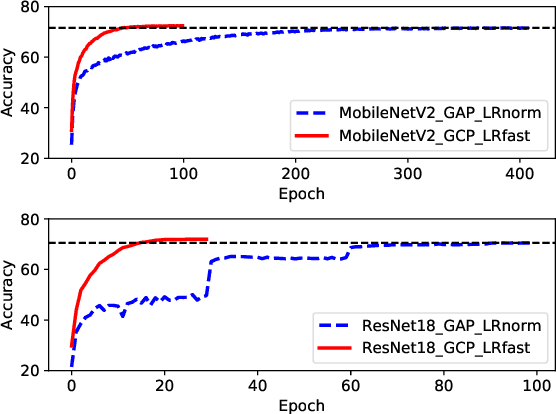
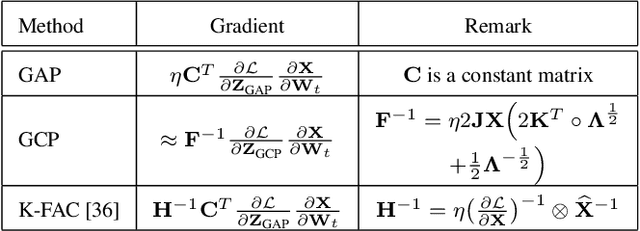
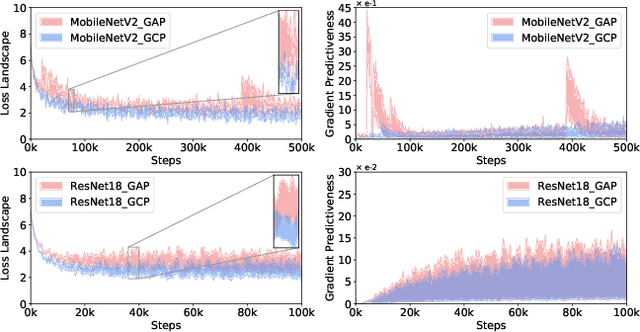

Abstract:Recent works have demonstrated that global covariance pooling (GCP) has the ability to improve performance of deep convolutional neural networks (CNNs) on visual classification task. Despite considerable advance, the reasons on effectiveness of GCP on deep CNNs have not been well studied. In this paper, we make an attempt to understand what deep CNNs benefit from GCP in a viewpoint of optimization. Specifically, we explore the effect of GCP on deep CNNs in terms of the Lipschitzness of optimization loss and the predictiveness of gradients, and show that GCP can make the optimization landscape more smooth and the gradients more predictive. Furthermore, we discuss the connection between GCP and second-order optimization for deep CNNs. More importantly, above findings can account for several merits of covariance pooling for training deep CNNs that have not been recognized previously or fully explored, including significant acceleration of network convergence (i.e., the networks trained with GCP can support rapid decay of learning rates, achieving favorable performance while significantly reducing number of training epochs), stronger robustness to distorted examples generated by image corruptions and perturbations, and good generalization ability to different vision tasks, e.g., object detection and instance segmentation. We conduct extensive experiments using various deep CNN models on diversified tasks, and the results provide strong support to our findings.
ECA-Net: Efficient Channel Attention for Deep Convolutional Neural Networks
Oct 08, 2019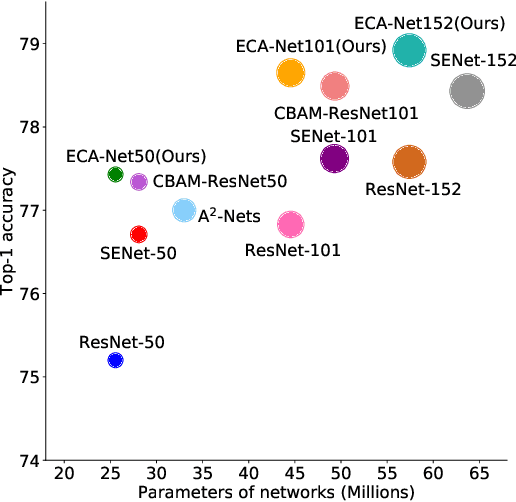
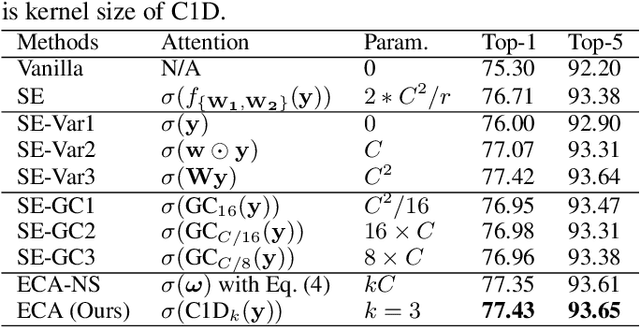
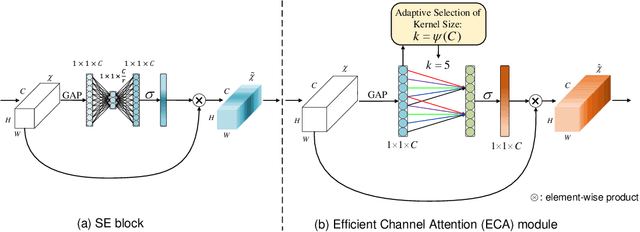
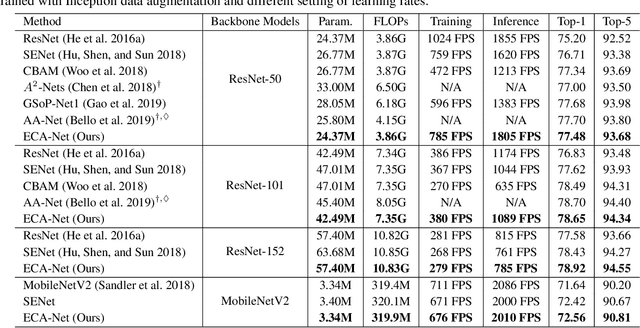
Abstract:Channel attention has recently demonstrated to offer great potential in improving the performance of deep convolutional neural networks (CNNs). However, most existing methods dedicate to developing more sophisticated attention modules to achieve better performance, inevitably increasing the computational burden. To overcome the paradox of performance and complexity trade-off, this paper makes an attempt to investigate an extremely lightweight attention module for boosting the performance of deep CNNs. In particular, we propose an Efficient Channel Attention (ECA) module, which only involves $k (k < 9)$ parameters but brings clear performance gain. By revisiting the channel attention module in SENet, we empirically show avoiding dimensionality reduction and appropriate cross-channel interaction are important to learn effective channel attention. Therefore, we propose a local cross-channel interaction strategy without dimension reduction, which can be efficiently implemented by a fast 1D convolution. Furthermore, we develop a function of channel dimension to adaptively determine kernel size of 1D convolution, which stands for coverage of local cross-channel interaction. Our ECA module can be flexibly incorporated into existing CNN architectures, and the resulting CNNs are named by ECA-Net. We extensively evaluate the proposed ECA-Net on image classification, object detection and instance segmentation with backbones of ResNets and MobileNetV2. The experimental results show our ECA-Net is more efficient while performing favorably against its counterparts. The source code and models can be available at https://github.com/BangguWu/ECANet.
 Add to Chrome
Add to Chrome Add to Firefox
Add to Firefox Add to Edge
Add to Edge